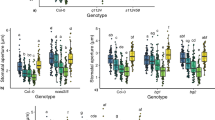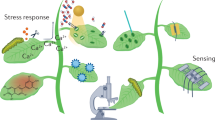Abstract
We provide here a detailed protocol for studying the changes in electrical surface potential of leaves. This method has been developed over the years by plant physiologists and is currently used in different variants in many laboratories. The protocol records surface potential changes to measure long-distance electrical signals induced by diverse stimuli such as leaf wounding or current injection. This technique can be used to determine signaling speeds, to measure the connectivity between different plant organs and—by exploiting mutant plants—to identify transporters and ion channels involved in electrical signaling. The approach can be combined with the analysis of mRNA expression and of metabolite concentrations to correlate electrical signaling to specific physiological events. We describe how to use this protocol on Arabidopsis, looking at the effects of leaf wounding; however, it is broadly applicable to other plants and can be used to study other aspects of plant physiology. After wound infliction, surface potential recording takes ∼20 min per plant.
This is a preview of subscription content, access via your institution
Access options
Subscribe to this journal
Receive 12 print issues and online access
$259.00 per year
only $21.58 per issue
Buy this article
- Purchase on Springer Link
- Instant access to full article PDF
Prices may be subject to local taxes which are calculated during checkout





Similar content being viewed by others
References
Hille, B. Ionic Channels of Excitable Membranes 2nd edn. (Sinauer Associates, 1992).
Bean, B.P. The action potential in mammalian central neurons. Nat. Rev. Neurosci. 8, 451–465 (2007).
Stankovic, B., Witters, D.L., Zawadzki, T. & Davies, E. Action potentials and variation potentials in sunflower: an analysis of their relationships and distinguishing characteristics. Physiol. Plantarum 103, 51–58 (1998).
Fromm, J. & Lautner, S. Electrical signals and their physiological significance in plants. Plant Cell Environ. 30, 249–257 (2007).
Brenner, E.D. et al. Plant neurobiology: an integrated view of plant signaling. Trends Plant Sci. 11, 413–419 (2006).
Stahlberg, R. Historical introduction to plant electrophysiology. in Plant Electrophysiology (ed. Volkov, A.G.) 3–14 (Springer, 2006).
Pickard, B.G. Action potentials in higher plants. Bot. Rev. 39, 172–201 (1973).
Sibaoka, T. Physiology of rapid movements in higher plants. Annu. Rev. Plant. Physiol. 20, 165–184 (1969).
Stahlberg, R. & Cosgrove, D.J. Rapid alterations in growth-rate and electrical potentials upon stem excision in pea-seedlings. Planta 187, 523–531 (1992).
Malone, M. Wound-induced hydraulic signals and stimulus transmission in Mimosa pudica L. New Phytol. 128, 49–56 (1994).
Davies, E. Electrical signals in plants: facts and hypotheses. in Plant Electrophysiology (ed. Volkov, A.G.) 407–422 (Springer, 2006).
Stahlberg, R., Cleland, R.E. & Van Volkenburgh, E. in Slow Wave Potentials: A Propagating Electrical Signal Unique to Higher Plants. Communication in Plants (eds. Baluska, F., Mancuso, S., & Volkmann, D.) 291–308 (Springer, 2006).
Zimmermann, M.R., Maischak, H., Mithofer, A., Boland, W. & Felle, H.H. System potentials, a novel electrical long-distance apoplastic signal in plants, induced by wounding. Plant Physiol. 149, 1593–1600 (2009).
Mousavi, S.A., Chauvin, A., Pascaud, F., Kellenberger, S. & Farmer, E.E. GLUTAMATE RECEPTOR-LIKE genes mediate leaf-to-leaf wound signalling. Nature 500, 422–426 (2013).
Felle, H.H. & Zimmermann, M.R. Systemic signalling in barley through action potentials. Planta 226, 203–214 (2007).
Fensom, D.S. The bioelectric potentials of plants and their functional significance. V. Some daily and seasonal changes in the electrical potential and resistance of living trees. Can. J. Botany 41, 831–851 (1963).
Fromm, J. & Spanswick, R. Characteristics of action-potentials in willow (Salix viminalis L.). J. Exp. Bot. 44, 1119–1125 (1993).
Favre, P. & Degli Agosti, R. Voltage-dependent action potentials in Arabidopsis thaliana. Physiol Plant 131, 263–272 (2007).
Carpaneto, A. et al. Cold transiently activates calcium-permeable channels in Arabidopsis mesophyll cells. Plant Physiol. 143, 487–494 (2007).
Minorsky, P.V. Temperature sensing by plants: a review and hypothesis. Plant Cell Environ. 12, 119–135 (1989).
Krol, E., Dziubinska, H. & Trebacz, K. Low-temperature-induced transmembrane potential changes in mesophyll cells of Arabidopsis thaliana, Helianthus annuus and Vicia faba. Physiol. Plant 120, 265–270 (2004).
Newman, I.A. Ion transport in roots: measurement of fluxes using ion-selective microelectrodes to characterize transporter function. Plant Cell Environ. 24, 1–14 (2001).
Maffei, M., Bossi, S., Spiteller, D., Mithofer, A. & Boland, W. Effects of feeding Spodoptera littoralis on Lima bean leaves. I. Membrane potentials, intracellular calcium variations, oral secretions, and regurgitate components. Plant Physiol. 134, 1752–1762 (2004).
Schaller, A. & Oecking, C. Modulation of plasma membrane H+-ATPase activity differentially activates wound and pathogen defense responses in tomato plants. Plant Cell 11, 263–272 (1999).
Wildon, D.C. et al. Electrical signaling and systemic proteinase-inhibitor induction in the wounded plant. Nature 360, 62–65 (1992).
Stahlberg, R. & Cosgrove, D.J. The propagation of slow wave potentials in pea epicotyls. Plant Physiol. 113, 209–217 (1997).
Farmer, E.E., Mousavi, S.A. & Lenglet, A. Leaf numbering for experiments on long distance signalling in Arabidopsis. Protoc. Exchange doi:10.1038/protex.2013.071 (2013).
Acknowledgements
We thank M. Blanchard and F. Pascaud for help with the electrophysiology approaches. This research was supported by a Faculty of Biology and Medicine Interdisciplinary grant (to S.K. and E.E.F.) and by Swiss National Science Foundation grant no. 31003A-138235 (to E.E.F.).
Author information
Authors and Affiliations
Contributions
S.A.R.M. developed the technique together with S.K. and E.E.F. and provided some figures; C.T.N. applied the technique, drafted the manuscript and provided most figures; and S.K. and E.E.F. wrote the manuscript. All authors contributed to the final manuscript.
Corresponding author
Ethics declarations
Competing interests
The authors declare no competing financial interests.
Rights and permissions
About this article
Cite this article
Mousavi, S., Nguyen, C., Farmer, E. et al. Measuring surface potential changes on leaves. Nat Protoc 9, 1997–2004 (2014). https://doi.org/10.1038/nprot.2014.136
Published:
Issue Date:
DOI: https://doi.org/10.1038/nprot.2014.136
This article is cited by
-
Early detection of dark-affected plant mechanical responses using enhanced electrical signals
Plant Methods (2024)
-
A bioinspired, self-powered, flytrap-based sensor and actuator enabled by voltage triggered hydrogel electrodes
Nano Research (2023)
-
Plant electrome: the electrical dimension of plant life
Theoretical and Experimental Plant Physiology (2019)
Comments
By submitting a comment you agree to abide by our Terms and Community Guidelines. If you find something abusive or that does not comply with our terms or guidelines please flag it as inappropriate.



